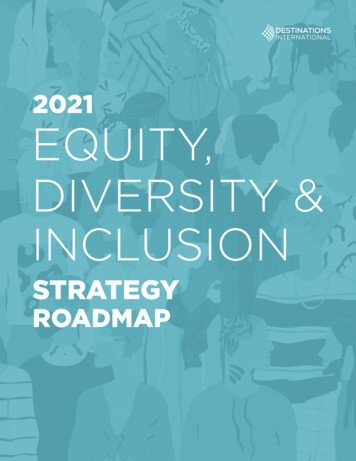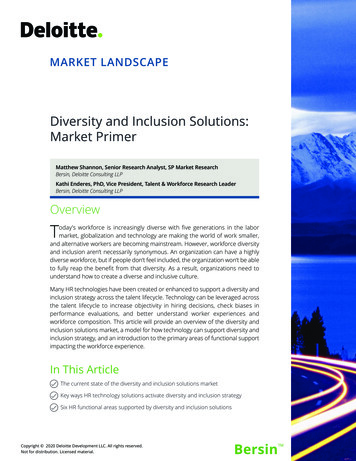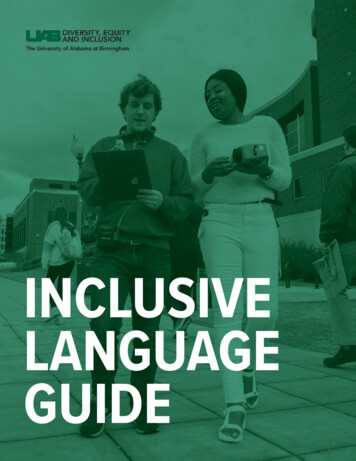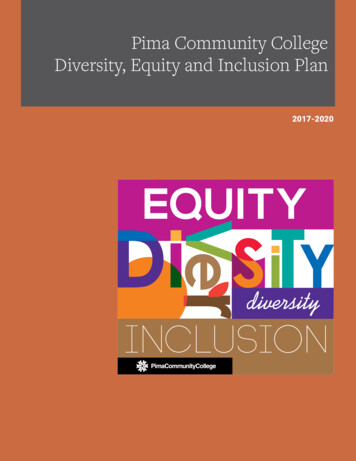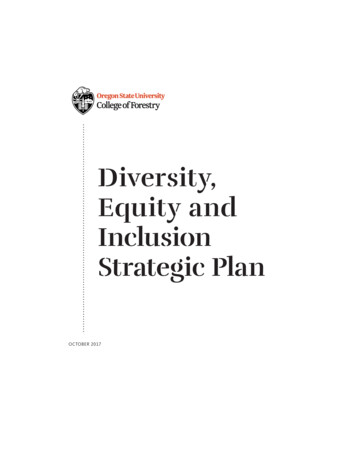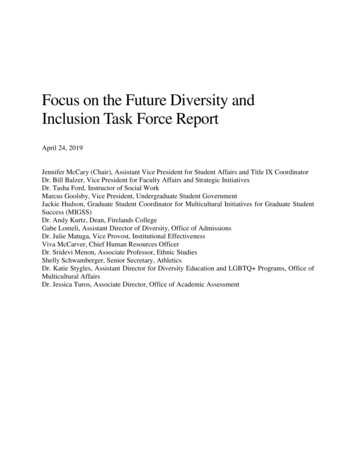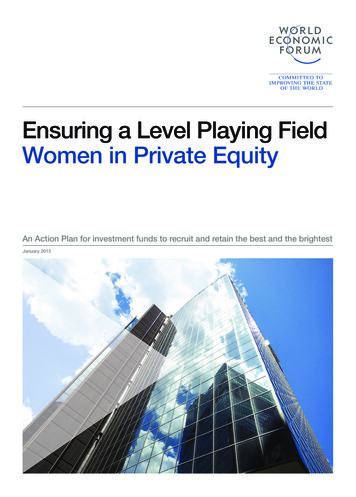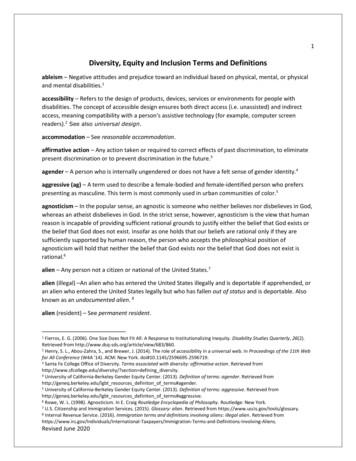
Transcription
1Diversity, Equity and Inclusion Terms and Definitionsableism – Negative attitudes and prejudice toward an individual based on physical, mental, or physicaland mental disabilities.1accessibility – Refers to the design of products, devices, services or environments for people withdisabilities. The concept of accessible design ensures both direct access (i.e. unassisted) and indirectaccess, meaning compatibility with a person's assistive technology (for example, computer screenreaders).2 See also universal design.accommodation – See reasonable accommodation.affirmative action – Any action taken or required to correct effects of past discrimination, to eliminatepresent discrimination or to prevent discrimination in the future.3agender – A person who is internally ungendered or does not have a felt sense of gender identity.4aggressive (ag) – A term used to describe a female-bodied and female-identified person who preferspresenting as masculine. This term is most commonly used in urban communities of color.5agnosticism – In the popular sense, an agnostic is someone who neither believes nor disbelieves in God,whereas an atheist disbelieves in God. In the strict sense, however, agnosticism is the view that humanreason is incapable of providing sufficient rational grounds to justify either the belief that God exists orthe belief that God does not exist. Insofar as one holds that our beliefs are rational only if they aresufficiently supported by human reason, the person who accepts the philosophical position ofagnosticism will hold that neither the belief that God exists nor the belief that God does not exist isrational.6alien – Any person not a citizen or national of the United States.7alien (illegal) –An alien who has entered the United States illegally and is deportable if apprehended, oran alien who entered the United States legally but who has fallen out of status and is deportable. Alsoknown as an undocumented alien. 8alien (resident) – See permanent resident.1Fierros, E. G. (2006). One Size Does Not Fit All: A Response to Institutionalizing Inequity. Disability Studies Quarterly, 26(2).Retrieved from http://www.dsq-sds.org/article/view/683/860.2 Henry, S. L., Abou-Zahra, S., and Brewer, J. (2014). The role of accessibility in a universal web. In Proceedings of the 11th Webfor All Conference (W4A '14). ACM: New York. doi#10.1145/2596695.2596719.3 Santa Fe College Office of Diversity. Terms associated with diversity: affirmative action. Retrieved fromhttp://www.sfcollege.edu/diversity/?section defining diversity.4 University of California-Berkeley Gender Equity Center. (2013). Definition of terms: agender. Retrieved fromhttp://geneq.berkeley.edu/lgbt resources definiton of terms#agender.5 University of California-Berkeley Gender Equity Center. (2013). Definition of terms: aggressive. Retrieved fromhttp://geneq.berkeley.edu/lgbt resources definiton of terms#aggressive.6 Rowe, W. L. (1998). Agnosticism. In E. Craig Routledge Encyclopedia of Philosophy. Routledge: New York.7 U.S. Citizenship and Immigration Services. (2015). Glossary: alien. Retrieved from https://www.uscis.gov/tools/glossary.8 Internal Revenue Service. (2016). Immigration terms and definitions involving aliens: illegal alien. Retrieved ing-Aliens.Revised June 2020
2ally – Someone who makes the commitment and effort to recognize their privilege (based on gender,class, race, sexual identity, etc.) and who works in solidarity with oppressed groups in the struggle forjustice.9Americans with Disabilities Act (ADA) – Enacted in 1990, the ADA is a civil rights law that prohibitsdiscrimination against individuals with disabilities in all areas of public life, including jobs, schools,transportation and all public and private places that are open to the public. The purpose of the law is tomake sure that people with disabilities have the same rights and opportunities as everyone else. TheADA is divided into five titles (or sections) that relate to different areas of public life – employment,state and local government, public accommodations, telecommunications and miscellaneousprovisions.10androgyny – Someone who reflects an appearance that is both masculine and feminine, or who appearsto be neither or both a boy and a girl.11anti-Semitism – Refers to prejudice and/or discrimination against Jews as individuals and as a group.Anti-Semitism is based on stereotypes and myths that target Jews as a people, their religious practicesand beliefs and the Jewish State of Israel.12asexual – Refers to a person who does not experience sexual attraction or has little interest in sexualactivity.13assimilation – The process whereby a group gradually adopts the characteristics of another culture.14atheism – A lack of belief in gods and supernatural beings.15bias – A tendency to believe that some people, ideas, etc., are better than others that usually results intreating some people unfairly.16bicultural – A person who is bicultural could function effectively and appropriately and can selectappropriate behaviors, values and attitudes within two cultures.179OpenSource Leadership Strategies. The dynamic system of power, privilege and oppressions (PDF). Retrieved DO%20Definitions.pdf.10 ADA National Network. What is the Americans with Disabilities Act (ADA)? Retrieved from https://adata.org/learn-about-ada.11 Movimiento Estudiantil Chican@ de Aztlán. (2003). Glossary of terms relating to sexuality and gender (PDF). Retrieved fromhttp://www.nationalmecha.org/documents/GS Terms.pdf.12 Anti-Defamation League. (2013). A brief history of anti-Semitism (PDF). Retrieved ch/Brief-History-on-Anti-Semitism-A.pdf.13 American Psychological Association - Divisions 16 and 44. (2015). Key terms and concepts in understanding gender diversityand sexual orientation among students [Pamphlet]. Retrieved from /lgbt/key-terms.pdf.14 Santa Fe College Office of Diversity. Terms associated with diversity: assimilation. Retrieved fromhttp://www.sfcollege.edu/diversity/?section defining diversity.15 American Atheists. What is atheism? (n.d.). Retrieved from heism.16 Bias [Def. simple]. (n.d.). In Merriam Webster Online, Retrieved February 19, 2016, from http://www.merriamwebster.com/dictionary/bias.17 Santa Fe College Office of Diversity. Terms associated with diversity: bicultural. Retrieved fromhttp://www.sfcollege.edu/diversity/?section defining diversity.Revised June 2020
3bicurious – A curiosity about having sexual relations with a same gender/sex person.18bigendered (1)– A person whose gender identity is a combination of male/man and female/woman.19bigendered (2) - Similar to bisexual. Can be used to describe people who identify with two or moregenders. Refers to those who identify as two genders. Can also identify as multigender (identifying astwo or more genders). Do not confuse this term with Two-Spirit, which is specifically associated withNative American and First Nations cultures.”20bigotry – Intolerant prejudice that glorifies one's own group and denigrates members of other groups.21biological sex – Refers to a person’s biological status and is typically categorized as male, female orintersex. There are many indicators of biological sex, including sex chromosomes, gonads, internalreproductive organs and external genitalia.22biphobia – The irrational fear and intolerance of people who are bisexual.23biphobia (internalized) – When a person who is bisexual is uncomfortable or not accepting of his/herown sexual orientation; this is because the person has been taught by society and possibly his or hercommunity that being bisexual is unacceptable, immoral, does not exist or is a phase.24bisexual (1) – Also bi. Having emotional, romantic or sexual attractions to both men and women,25 butnot necessarily simultaneously or equally.26bisexual (2) - This term is used differently by different people. It can be used to mean attraction to twogenders, attraction to men and women specifically, or attraction to all genders, or attraction regardlessof gender.27blind – A term most frequently used to describe a severe vision loss. Either blind or low vision areacceptable terms to describe all degrees of vision loss.2818Green, E. R., & Peterson, E. N. [LGBT Resource Center at UC Riverside]. (2006). LGBTQI terminology (PDF). Retrieved logy.pdf.19 Green, E. R., & Peterson, E. N. [LGBT Resource Center at UC Riverside]. (2006). LGBTQI terminology (PDF). Retrieved logy.pdf.20Trans Student Educational Resource - http://www.transstudent.org/definitions/21Racial Equity Resource Guide. (n.d.). Glossary. Retrieved from ssary.American Psychological Association. (2012). Guidelines for psychological practice with lesbian, gay, and bisexual clients.American Psychologist, 67(1), 10-42. doi: 10.1037/a002465923 Movimiento Estudiantil Chican@ de Aztlán. (2003). Glossary of terms relating to sexuality and gender (PDF). Retrieved fromhttp://www.nationalmecha.org/documents/GS Terms.pdf.24 Ball State University. (n.d.). Safe zone training (PDF). Retrieved from al%20-%20Full%20Version%20May%202012.pdf.25 American Psychological Association. (2008). Answers to your questions: For a better understanding of sexual orientation andhomosexuality. Washington, DC: Author. Retrieved from www.apa.org/topics/sorientation.pdf.26 Movimiento Estudiantil Chican@ de Aztlán. (2003). Glossary of terms relating to sexuality and gender (PDF). Retrieved fromhttp://www.nationalmecha.org/documents/GS Terms.pdf.2227The attached resource provides many definitions for bisexuality from different ition-of-bisexuality-according-to-bi/28ABILITY magazine. (n.d.). Guidelines to terminology. Retrieved from vised June 2020
4butch – An overtly/stereotypically masculine or masculine-acting woman. Can be used to denote anindividual, or the dominant role in a lesbian relationship.29camp – A form of humor in which one makes fun of one’s oppression by taking on and exaggeratingstereotypes which the oppressor projects onto the oppressed. Camp makes fun of stereotypes andlaughs at the sting of oppression.30cisgender – Replaces the terms nontransgender or bio man/bio woman to refer to individuals who havea match between the sex they were assigned at birth, their bodies and their gender identity.31cissexism – The set of attitudes and behaviors which value and normalize cisgender people, whilekeeping transgender and gender non-conforming people invisible or treating them as inferior ordeviant.32Civil Rights Act of 1964 – The Act outlawed discrimination based on race, color, religion, sex or nationalorigin, required equal access to public places and employment and enforced desegregation of schoolsand the right to vote. It did not end discrimination, but it did open the door to further progress.33civil union – A relationship between a couple that is legally recognized by a governmental authority andhas many of the rights and responsibilities of marriage. See also marriage and domestic partnership.34classism – Any attitude or institutional practice which subordinates people due to income, occupation,education and/or their economic condition.35closeted – The opposite of being out, being closeted means that one's sexual orientation is concealed orpresumed to be heterosexual.36collusion – When people act to perpetuate oppression or prevent others from working to eliminateoppression.37colonialism – Colonization can be defined as some form of invasion, dispossession and subjugation of apeople. The invasion need not be military; it can begin—or continue—as geographical intrusion in theform of agricultural, urban or industrial encroachments. The result of such incursion is the dispossession29Butch (n.d.). In LGBTQ Lexicon Online, Retrieved March 23, 2016, from http://lgbtqlexicon.net/butch/.Southern Illinois University-Edwardsville: Safe Zone. (n.d.). LGBT terminology. Retrieved fromhttps://www.siue.edu/lgbt/definitions.shtml.31 American Psychological Association - Divisions 16 and 44. (2015). Key terms and concepts in understanding gender diversityand sexual orientation among students [Pamphlet]. Retrieved from /lgbt/key-terms.pdf.32 Grollman, E. A. (2012). What is transphobia? and, what is cissexism? Retrieved fromhttp://kinseyconfidential.org/transphobia/.33 National Park Service. (n.d.). Civil Rights Act of 1964. Retrieved from rights-act.htm.34 Southern Illinois University-Edwardsville: Safe Zone. (n.d.). LGBT terminology. Retrieved fromhttps://www.siue.edu/lgbt/definitions.shtml.35 Santa Fe College Office of Diversity. Terms associated with diversity: classism. Retrieved fromhttp://www.sfcollege.edu/diversity/?section defining diversity.36 University of Alaska-Southeast. (n.d.). LGBTIQ terminology and definitions (PDF). Retrieved fezone/docs/lgbtiq terminology.pdf.37 Adams, M., Bell, L. A., & Griffin, P. (1997). Teaching for diversity and social justice: A sourcebook. New York, NY: Routledge.30Revised June 2020
5of vast amounts of lands from the original inhabitants. This is often legalized after the fact. The longterm result of such massive dispossession is institutionalized inequality. The colonizer/colonizedrelationship is by nature an unequal one that benefits the colonizer at the expense of the colonized.38‘coming out’ (1)– Shorthand for coming out of the closet. The phrase is used to refer to several aspectsof lesbian, gay and bisexual persons' experiences: self-awareness of same-sex attractions; the telling ofone or a few people about these attractions; widespread disclosure of same-sex attractions; andidentification with the lesbian, gay and bisexual community.39“coming out” (2) - The process of becoming aware of one’s queer sexual orientation, one’s 2-Spirit ortrans* identity, accepting it, and telling others about it. LGBT people may come out in reference toboth gender and sexuality and often have to come out repeatedly to new people. This is an ongoingprocess that may not include everybody in all aspects of one’s life. ‘Coming out’ usually occurs in stagesand is a non-linear process. An individual may be ‘out’ in only some situations or to certain familymembers or associates and not others. Some may never ‘come out’ to anyone beside themselves.”40Communism – a political theory from Karl Marx advocating class war and leading to a society in which allproperty is publicly owned, and each person works and is paid according to their abilities and needs41Critical Race Theory – The Critical Race Theory movement considers many of the same issues thatconventional civil rights and ethnic studies take up, but places them in a broader perspective thatincludes economics, history, and even feelings and the unconscious. Unlike traditional civil rights, whichembraces incrementalism and step by step progress, critical race theory questions the very foundationsof the liberal order, including equality theory, legal reasoning, Enlightenment rationalism and principlesof constitutional law.42cross-dresser – People who cross-dress wear clothing that is traditionally or stereotypically worn byanother gender in their culture. They vary in how completely they cross-dress, from one article ofclothing to fully cross-dressing. Those who cross-dress are usually comfortable with their assigned sexand do not wish to change it. Cross-dressing is a form of gender expression and is not necessarily tied toerotic activity. Cross-dressing is not indicative of sexual orientation.4338LaRocque, E. (n.d.). Colonization and racism. Retrieved x.php?mode theme&language english&theme 30662&film 16933&excerpt 612109&submode about&expmode 2.39 American Psychological Association. (2008). Sexual orientation & homosexuality: Answers to your questions for a betterunderstanding. Retrieved from Qmunity - http://qmunity.ca/wpcontent/uploads/2015/03/Queer Terminology Web Version Sept 2013 Cover and pages .pdf41Dobbs, D. (2000). Communism. The Journal of Politics, 62(2), 491-510.42Delgado, R. & Stefancic, J. (2001). Critical Race Theory: An introduction. New York: New York University Press.American Psychological Association. (2011). Answers to your questions about transgender people, gender identity, and genderexpression. Retrieved from Revised June 2020
6culture – The shared patterns of behaviors and interactions, cognitive constructs and affectiveunderstanding that are learned through a process of socialization. These shared patterns identify themembers of a culture group while also distinguishing those of another group.44cultural appropriation – Theft of cultural elements for one’s own use, commodification, or profit —including symbols, art, language, customs, etc. — often without understanding, acknowledgement orrespect for its value in the original culture. Results from the assumption of a dominant (i.e. white)culture’s right to take other cultural elements.45cultural competence – A set of congruent behaviors, attitudes and policies that come together in asystem, agency or among professionals to enable that system, agency or those professions to workeffectively in cross-cultural situations. The word culture is used because it implies the integrated patternof human behavior that includes thoughts, communications, actions, customs, beliefs, values andinstitutions of a racial, ethnic, religious or social group. The word competence is used because it implieshaving the capacity to function effectively.Five essential elements contribute to a system's, institution's or agency's ability to become moreculturally competent which include: valuing diversity;having the capacity for cultural self-assessment;being conscious of the dynamics inherent when cultures interact;having institutionalized culture knowledge; andhaving developed adaptations to service delivery reflecting an understanding of culturaldiversity.These five elements should be manifested at every level of an organization including policy making,administrative and practice. Further, these elements should be reflected in the attitudes, structures,policies and services of the organization.4647cultural conditioning – The unconscious process by which we are socialized to adopt the way of thinkingof our own group.4844University of Minnesota Center for Advanced Research on Language Acquisition. (n.d.). What is culture? Retrieved 45 Colours of Resistance. (n.d.). Cultural appropriation. Retrieved from turalappropriation/.46 National Center for Cultural Competence, Georgetown University, Center for Child and Human Development. (n.d.). Curriculaenhancement module series: Definitions of cultural competence. Retrieved tml.47 Cross, T., Bazron, B., Dennis, K., & Isaacs, M., (1989). Towards a culturally competent system of care, Volume 1. Washington,D.C.: Georgetown University Child Development Center, CASSP Technical Assistance Center.48 Santa Fe College Office of Diversity. Terms associated with diversity: cultural conditioning. Retrieved fromhttp://www.sfcollege.edu/diversity/?section defining diversity.Revised June 2020
7cultural essentialism – The practice of categorizing groups of people within culture or from othercultures according to essential qualities49cultural humility – The ability to maintain an interpersonal stance that is other-oriented (or open to theother) in relation to aspects of cultural identity that are most important to the [person]. Culturalhumility focuses on taking responsibility for our interactions with others rather than achieving a state ofknowledge or awareness. The approach of cultural humility goes beyond the concept of culturalcompetence to encourage individuals to identify and acknowledge their own biases. Cultural humilityacknowledges that it is impossible to be adequately knowledgeable about cultures other than one’sown.50 Principles that guide the cultural humility approach: lifelong learning and critical self-reflection;recognizing and mitigating/challenging power imbalances; andinstitutional accountability to model the principles.51cultural pluralism – Recognition of the contribution of each group to a common civilization. Itencourages the maintenance and development of different lifestyles, languages and convictions. It is acommitment to deal cooperatively with common concerns. It strives to create the conditions ofharmony and respect within a culturally diverse society.52culture – A social system of meaning and custom that is developed by a group of people to assure itsadaptation and survival. These groups are distinguished by a set of unspoken rules that shape values,beliefs, habits, patterns of thinking, behaviors and styles of communication.53deaf culture – Describes the social beliefs, behaviors, art, literary traditions, history, values and sharedinstitutions of communities that are affected by deafness and which use sign languages as the mainmeans of communication.54Demi-sexual – A person who does not experience sexual attraction unless they form an emotionalconnection. It's more commonly seen in but by no means confined to romantic relationships. Theterm Demi-sexual comes from the orientation being "halfway between" sexual and asexual.5549Matthes, E. H. (2016). Cultural Appropriation Without Cultural Essentialism?. Social Theory & Practice, 42(2),343-366.50Levi, A. (2009). The ethics of nursing student international clinical experiences. Journal of Obstetric, Gynecologic, andNeonatal Nursing, 38(1), 94-99.51 Tervalon, M. & Murray-Garcia, J. (1998). Cultural humility versus cultural competence: a critical distinction in definingphysician training outcomes in multicultural education. Journal of Health Care for the Poor and Underserved, 9(2), 117-125.52 Institute for Democratic Renewal and Project Change Anti-Racism Initiative. (n.d.). 15 tools for creating healthy, productiveinterracial/multiracial communities: A community builder's tool kit (PDF). Retrieved /idr.pdf.53 Institute for Democratic Renewal and Project Change Anti-Racism Initiative. (n.d.). 15 tools for creating healthy, productiveinterracial/multiracial communities: A community builder's tool kit (PDF). Retrieved /idr.pdf.54 Santa Fe College Office of Diversity. Terms associated with diversity: deaf culture. Retrieved fromhttp://www.sfcollege.edu/diversity/?section defining diversity.55Yule, M.A., Brotto L.A., Gorzalka B.B. (2017). Human Asexuality: What Do We Know About a Lack of SexualAttraction?. Current Sexual Health Reports. Volume 9, Issue 1, pp 50–56Revised June 2020
8denial – Refusal to acknowledge the societal privileges that are granted or denied based on anindividual's ethnicity or other grouping.56diaspora – The voluntary or forcible movement of peoples from their homelands into new regions;these are people who live outside their natal (or imagined natal) territories and recognize that theirtraditional homelands are reflected deeply in the languages they speak, religions they adopt and thecultures they produce.5758disability – A functional limitation that affects an individual’s ability to perform certain functions.59disability (ADA) – A person who has a physical or mental impairment that substantially limits one ormore major life activity. This includes people who have a record of such an impairment, even if they donot currently have a disability. It also includes individuals who do not have a disability but are regardedas having a disability. The ADA also makes it unlawful to discriminate against a person based on thatperson’s association with a person with a disability.60discrimination – Behavior that treats people unequally because of their group memberships.Discriminatory behavior, ranging from slights to hate crimes, often begins with negative stereotypes andprejudices.61discrimination (legal) – In constitutional law, discrimination is the grant by statute of privileges to a classarbitrarily designated from a sizable number of persons, where no reasonable distinction exists betweenthe favored and disfavored classes. Federal laws, supplemented by court decisions, prohibitdiscrimination in such areas as employment, housing, voting rights, education and access to publicfacilities. They also proscribe discrimination based on race, age, sex, nationality, disability or religion. Inaddition, state and local laws can prohibit discrimination in these areas and in others not covered byfederal laws.62diversity – Diversity includes all the ways in which people differ, and it encompasses all the differentcharacteristics that make one individual or group different from another. A broad definition includes notonly race, ethnicity and gender — the groups that most often come to mind when the term diversity isused — but also age, national origin, religion, disability, sexual orientation, socioeconomic status,56Institute for Democratic Renewal and Project Change Anti-Racism Initiative. (n.d.). 15 tools for creating healthy, productiveinterracial/multiracial communities: A community builder's tool kit (PDF). Retrieved /idr.pdf.57 Diaspora: Definitional Differences. (2002, March 03). Retrieved April 11, 2016, oft.html58 Ashcroft, B., Garet, G., and Tiffin, H. (1998). Key concepts in post-colonial studies. London and New York: Routledge.59 ABILITY magazine. (n.d.). Guidelines to terminology. Retrieved from http://www.abilitymagazine.com/terminology.html.60 ADA National Network. (n.d.). What is the definition of disability under the ADA? Retrieved from der-ada.61 Southern Poverty Law Center. (n.d.). Test yourself for hidden bias. Retrieved from den-bias.62 Discrimination (n.d.). In the Free Dictionary Online, Retrieved March 24, 2016, from imination.Revised June 2020
9education, marital status, language and physical appearance. It also involves different ideas,perspectives and values.63domestic partner – Domestic partnerships create a legal relationship for the couple that is like marriagein many states. In many states domestic partnerships mean that the couple will be treated the same as amarried couple. In others, domestic partnerships are no more than a cohabitation agreement withcouples receiving fewer rights than married couples.64 See also civil union and marriage.drag/drag queen or king – Men who dress as women for entertaining others at bars, clubs or otherevents. The term drag king refers to women who dress as men for entertaining others at bars, clubs orother events.65Dysphoria – profound state of unease or dissatisfaction. Dysphoria may accompany depression, anxiety,or agitation. It can also mean someone that is not comfortable in their current body, particularly in casesof gender dysphoria. 66emigration – The act of leaving one’s own country to settle permanently in another, moving abroad. Seealso immigration.67empowerment – When target group members refuse to accept the dominant ideology and theirsubordinate status and take actions to redistribute social power more equitably.68equity – The proactive reinforcement of policies, practices, attitudes and actions that produce equitablepower, access, opportunities, treatment, impacts and outcomes for all.69equity (campus context) – The creation of opportunities for historically underrepresented populationsto have equal access to and participate in educational programs that can close the achievement gaps instudent success and completion.70ethnicity – A dynamic set of historically derived and institutionalized ideas and practices that (1) allowspeople to identify or to be identified with groupings of people based on presumed (and usually claimed)commonalities including language, history, nation or region of origin, customs, ways of being, religion,63University of California-Berkeley Center for Equity, Inclusion and Diversity. (n.d.). Glossary of terms. Retrieved 4 Akhbari, K. (2015, August 18). The ultimate guide to gay marriage laws. Retrieved from ate-guide-to-gay-marriage-laws.html.65 American Psychological Association. (2011). Answers to your questions about transgender people, gender identity, and genderexpression. Retrieved from Cole, C.M., O'Boyle, M., Emory, L.E. et al. (1997). Comorbidity of Gender Dysphoria and Other Major PsychiatricDiagnoses. Archives of Sex Behavior Vol. 26 Issue. 1 13-26.67Emigration (n.d.). In Oxford Dictionaries Online, Retrieved February 19, 2016, n/american english/emigration.68 Adams, M., Bell, L. A., and Griffin, P. (1997). Teaching for diversity and social justice: A sourcebook. New York, NY: Routledge.69 Applied Research Center. (20
1 Revised June 2020 Diversity, Equity and Inclusion Terms and Definitions ableism – Negative attitudes and prejudice toward an individual based on physical, mental, or physical and mental disabilities.1 accessibility – Refers to the design of products, devices, services or environments for people with disabilitie

